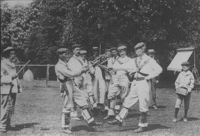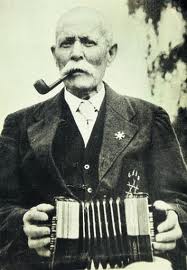Annotation:Headington Morris Reel: Difference between revisions
m (Text replace - "[[{{BASEPAGENAME}}|Tune properties and standard notation]]" to "'''Back to [[{{BASEPAGENAME}}]]'''") |
m (Text replacement - "garamond, serif" to "sans-serif") |
||
| (5 intermediate revisions by one other user not shown) | |||
| Line 1: | Line 1: | ||
'''Back to [[{{BASEPAGENAME}}]]''' | =='''Back to [[{{BASEPAGENAME}}]]'''== | ||
---- | ---- | ||
<p><font face=" | <p><font face="sans-serif" size="4"> | ||
'''HEADINGTON MORRIS REEL'''. English, Morris Dance Tune (4/4 time). G Major. Standard tuning (fiddle). AABB (x4), A. From the village of Headington, in England's Cotswolds. | '''HEADINGTON MORRIS REEL'''. AKA and see "[[Morris Reel (2)]]." English, Morris Dance Tune (4/4 or 2/2 time). G Major. Standard tuning (fiddle). AABB (x4), A. From the village of Headington, in England's Cotswolds. A dance and tune collected from dancers in the village of Headington (Oxfordshire), in England's Cotswolds. Collector Cecil Sharp met anglo-concertina player William Kimber (1872-1961) the day after Christmas (Boxing Day), in 1899, playing for the Headington Quarry Morris Dancers. Kimber called "The Morris Reel (1)" by the title "[[Bold Huzzar (The)]]", although at times he also used a version of "Soldier's Joy" for the dance (recorded on HMV B.9672 in 1948. [[File:headington.gif|200px|thumb|right|Headington Quarry morris dancers, c. 1895 [http://www.themorrisring.org/publications/morris-tradition]]] | ||
Sharp's visit helped trigger his interest in English folk dance, which in turn led to a revival of traditional tunes and dances. Kimber was still playing when he was recorded in 1946 and 1948 in the studio by Douglas Kennedy, and later (in the 1950's) by Peter Kennedy. | |||
[[File:kimber.jpg|200px|thumb|left|William Kimber]] | |||
<br> | <br> | ||
<br> | <br> | ||
</font></p> | </font></p> | ||
<p><font face=" | <p><font face="sans-serif" size="4"> | ||
''Source for notated version'': | ''Source for notated version'': | ||
<br> | <br> | ||
<br> | <br> | ||
</font></p> | </font></p> | ||
<p><font face=" | <p><font face="sans-serif" size="4"> | ||
''Printed sources'': Mallinson ('''Mally's Cotswold Morris Book'''), 1988; No. 49, p. 30. | ''Printed sources'': Bacon ('''The Morris Ring'''), 1974; p. 189. Mallinson ('''Mally's Cotswold Morris Book'''), 1988; No. 49, p. 30. | ||
<br> | <br> | ||
<br> | <br> | ||
</font></p> | </font></p> | ||
<p><font face=" | <p><font face="sans-serif" size="4"> | ||
''Recorded sources'': <font color=teal></font> | ''Recorded sources'': <font color=teal></font> | ||
</font></p> | </font></p> | ||
| Line 22: | Line 24: | ||
<br> | <br> | ||
---- | ---- | ||
'''Back to [[{{BASEPAGENAME}}]]''' | =='''Back to [[{{BASEPAGENAME}}]]'''== | ||
Latest revision as of 14:23, 6 May 2019
Back to Headington Morris Reel
HEADINGTON MORRIS REEL. AKA and see "Morris Reel (2)." English, Morris Dance Tune (4/4 or 2/2 time). G Major. Standard tuning (fiddle). AABB (x4), A. From the village of Headington, in England's Cotswolds. A dance and tune collected from dancers in the village of Headington (Oxfordshire), in England's Cotswolds. Collector Cecil Sharp met anglo-concertina player William Kimber (1872-1961) the day after Christmas (Boxing Day), in 1899, playing for the Headington Quarry Morris Dancers. Kimber called "The Morris Reel (1)" by the title "Bold Huzzar (The)", although at times he also used a version of "Soldier's Joy" for the dance (recorded on HMV B.9672 in 1948.

Sharp's visit helped trigger his interest in English folk dance, which in turn led to a revival of traditional tunes and dances. Kimber was still playing when he was recorded in 1946 and 1948 in the studio by Douglas Kennedy, and later (in the 1950's) by Peter Kennedy.

Source for notated version:
Printed sources: Bacon (The Morris Ring), 1974; p. 189. Mallinson (Mally's Cotswold Morris Book), 1988; No. 49, p. 30.
Recorded sources:
